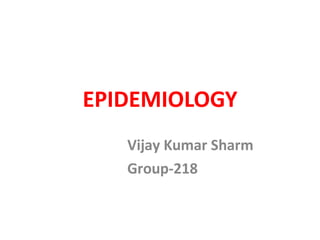
VZ7jXYlmW5BBPf5j98.pptx
- 2. What did we learn in Lecture 1? A quick Recap • Definition of epidemiology – “The study of the distribution and determinants of health-related states or events in specified populations, and the application of this study to the prevention and control of health problems” • The Epidemiological Approach – Asking Questions – Making comparisons • The aims of epidemiology – Describe disease – Distribution, frequency – Identify etiological factors – Provide data for planning and implementation and for priority setting
- 3. Lecture Objectives By the end of this lecture, the student will be able to: 1. Describe the tools of measurements in epidemiology. 2. Enumerate the FIVE elements in a rate. 3. Define and differentiate between incidence and prevalence. 4. Enumerate types of prevalence. 5. Calculate the prevalence of a disease/health- related behavior in a population.
- 4. Definitions and terms • Operational Definition: – “A definition embodying criteria used to identify and classify individual members of a set or concept to facilitate classification and counting.” • Population at risk: – “People who are potentially susceptible to the disease under study”. – “The group of people, healthy or sick, who would be counted as cases if they had the disease being studied”.
- 6. Tools of Measurement in Epidemiology
- 7. RATIO • “The value obtained by dividing one quantity by another” • Example: Sex ratio, Child-woman ratio
- 8. RATE • “the frequency with which an event occurs in a defined population, usually in a specified period of time”. • Example: Incidence rate
- 9. PROPORTION • “The ratio of a part to the whole, expressed as a “decimal fraction” (e.g., 0.2), as a “common fraction” (1/5), or as a percentage (20%)”. The proportion is a dimensionless quantity. • Example: Proportion of diabetics in a population.
- 10. The FIVE elements (or components) of a rate Number of events in a specified population during a specified period Rate = Average population during the period X n 10 Numerator Denominator Multiplier Time Population
- 12. INCIDENCE – WHAT IS IT? • “the number of new health-related events in a defined population within a specified period of time. It may be measured as a frequency count, a rate, or a proportion”.
- 13. PREVALENCE – WHAT IS IT? • “total number of individuals who have an attribute or disease at a particular time (it may be a particular period) divided by the population at risk of having the attribute or disease at that time or midway through the period”. • A measure of occurrence or disease frequency, often used to refer to the proportion of individuals in a population who have a disease or condition. • When used without qualification, the term usually refers to the situation at a specified point in time (point prevalence). • It is a proportion, not a rate.
- 15. PREVALENCE
- 16. Definition of prevalence • “total number of individuals who have an attribute or disease at a particular time (it may be a particular period) divided by the population at risk of having the attribute or disease at that time or midway through the period”. • A measure of occurrence or disease frequency, often used to refer to the proportion of individuals in a population who have a disease or condition. • It refers to NEW+OLD cases of the disease.
- 17. How is prevalence calculated? Numerator Denominator Multiplier
- 18. • Point prevalence – The proportion of individuals with a disease or an attribute at a specified point in time. Types of prevalence
- 19. • Period prevalence • The proportion of individuals with a disease or an attribute at a specified period of time. • To calculate a period prevalence, the denominator used most commonly is the ‘population at risk midway through the period’ (e.g., mid-year population) Types of prevalence – contd …
- 20. • Lifetime prevalence – The proportion of individuals who have had the disease or condition for at least part of their lives at any time during their lifecourse. Types of prevalence – contd …
- 22. • Estimate the magnitude of health/disease problems in the community and identify potential high-risk population groups. • Assessing the need for preventive action, healthcare and the planning of health services. • Prevalence is a useful measure of the occurrence of conditions for which the onset of disease may be gradual, such as hypertension, diabetes or rheumatoid arthritis. Uses of prevalence
- 23. • Prevalence studies do not usually provide strong evidence of causality. Disadvantages of prevalence
- 24. EXERCISES • Calculate the prevalence of disease in the given situations. • SITUATION 1: • In a population of 30000, 200 adolescents girls are anemic. Calculate the prevalence of anemia among adolescent girls if adolescent girls comprise 10% of the population?
- 25. • SITUATION 2: Jan 1, 2013 Dec 31, 2013 Population at risk =200 (on 1st July, 2013)